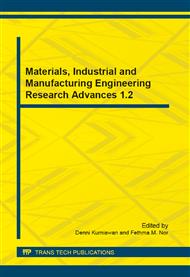p.15
p.19
p.25
p.29
p.35
p.41
p.47
p.51
p.55
Effect of Melt Temperature on the Interfacial Thermal Resistance and Solidification Behaviour of Al/SiCp Composites
Abstract:
The effect of melt temperature on the interfacial thermal resistance and solidification behaviour of A356/10% SiCp during squeeze casting is studied. The melt pouring temperatures are considered in the investigation within the range of 750 - 900°C respectively. The squeeze pressure is kept constant at 100 MPa. It was observed that the solidification time increased with the melt temperature from 40 seconds at 750°C to 51 seconds at 900°C. The results also showed that the cooling rate decreased with melt temperatures. The solidification time calculated from the theoretical expression was found to be in good agreement with that obtained from the experimental cooling curves. The interfacial thermal resistance value increases from 0.000043 to 0.000203 m2 K/W when the melt temperature is increased from 750 to 900°C.
Info:
Periodical:
Pages:
35-40
Citation:
Online since:
August 2014
Authors:
Price:
Сopyright:
© 2014 Trans Tech Publications Ltd. All Rights Reserved
Share:
Citation:


